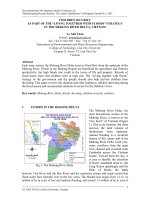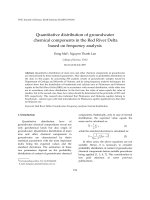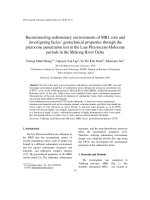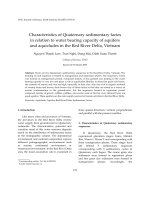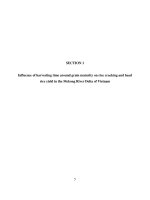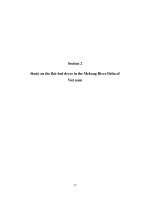Section 1:Influence of harvesting time around grain maturity on rice cracking and head rice yield in the Mekong River Delta of Vietnam " pdf
Bạn đang xem bản rút gọn của tài liệu. Xem và tải ngay bản đầy đủ của tài liệu tại đây (43.09 KB, 12 trang )
SECTION 1
Influence of harvesting time around grain maturity on rice cracking and head
rice yield in the Mekong River Delta of Vietnam
5
SECTION 1. Influence of harvesting time around grain maturity on rice
cracking and head rice yield in the Mekong River Delta of Vietnam
ABSTRACT
Timely harvesting plays an important role in controlling rice cracking. Reduced whole rice grain
yield due to cracking causes the value loss and reduces the farmers’ income. Field experiments
were carried out to study the effect of harvesting time around crop maturity on rice cracking and
head rice yield for seven common rice varieties (OM1490, OM2718, OM2517, OM4498, AG24,
IR50404 and Jasmine) in three different locations during two cropping years (2006-2008) in the
Mekong River Delta, Vietnam. The results showed that the rice cracking was strongly influenced
by both the variety and time of harvesting around maturity. There was a general trend of increase
in percentage of cracked rice with late harvesting in relation to estimated grain maturity date.
The head rice yield also followed the same trend in response to delayed harvesting. A delay of 46 days reduced the head rice yield by 11.3 % an average and up to 50 %. Similar trends were
observed in both wet and dry seasons. The large varietal difference in percentage of cracked
grain (0.9 to 60.5%) on 6 days after maturity date indicated that the level of rice cracking caused
by late harvesting time can be minimized by the selection of suitable varieties.
INTRODUCTION
Head rice yield, which is defined as the weight percentage of rough rice that remains as head rice
(the kernels that are at least ¾ of the original kernel length) after milling, is considered as the
main quality indicator because the broken rice has often half the commercial value of whole
grain rice. It has been shown that timeliness of harvesting can influence milling yield
significantly. Harvesting rice at crop maturity can give a maximum head rice yield (Kester et al.
1963, Bal and Oiha 1975). Any delay in harvesting time causes reduction of head rice yield (Bal
and Oiha 1975, Ntanos et al. 1996, Berrio et al. 1989) and extended delay in harvesting can lead
to significant losses in head rice yield. Berrio et al. (1989) showed that among 16 investigated
rice varieties studied the whole-milled grain was reduced by 18% when harvesting was delayed
6
by 2 weeks. However, it was also found that there was no impact of harvesting time on sensory
perception of rice (Champagne et al. 2005, Chae and Jun 2002).
The incidence of rice fissuring in the field has a potentially significant impact on head rice yield.
Cracking can develop in the field as a result of changes in grain moisture after the rice matures
due to hot sunny days followed by humid nights. Harvesting time affects proportion of cracked
rice and hence head rice yield. Large quantities of immature rice kernels can be detected in early
harvested rice. Immature kernels are usually thinner and defective, and are easily cracked during
subsequent milling (Swamy and Bhattacharya 1980). In contrast, late harvested grain is often
associated with a grain product that is too dry and more prone to fissuring. Investigations by
Chau and Kunze (1982) showed that cracking can develop in low-moisture content kernels (13%
or 14% wet basis) before harvesting as a consequence of the swings in relative humidity in the
atmosphere. Furthermore, improper post-harvest practices, such as a delay in threshing when rice
stacks are left in the field, can also provide the potential of moisture adsorption due to an uneven
moisture content and uneven maturity within the bulk rice (Kunze and Prasad 1978).
Reduced whole rice grain yield due to cracking is one of the major issues that directly reduce
income and availability of staple food to the farmers in the Mekong River Delta of Vietnam.
Mekong River Delta is the largest rice production region in Vietnam. The cracking or partial
fissuring of rice kernels may occur right in the paddy field due to incorrect harvesting time and
improper harvesting practices, and occur also due to adverse post-harvest drying conditions and
inappropriate milling operations. The weather pattern (temperature and humidity) in Mekong
River Delta is unique. The rice is grown and harvested in both wet and dry seasons. Weather
conditions at around harvesting period are different between the two seasons and this can impact
the rice fissuring and cracking during milling. However, there is no experimental data available
on the impact of harvesting time on rice cracking and head rice recovery on the rice varieties
grown at different seasons in the Mekong River Delta. This research work is an attempt to
systematically collect the rice cracking and head rice yield data based on field experimentations
in four consecutive harvesting seasons between 2006 and 2008. The main factor considered in
this study during the collection of data was harvesting time- before and after grain maturity. The
7
objective of this experiment was to evaluate the effects of harvesting time of several rice
varieties on the level of rice cracking and head rice yield in different seasons. This study will
assist to determine the optimal harvesting time for various rice varieties grown in the Mekong
River Delta.
MATERIALS AND METHODS
Rice samples
Experiments were carried out at three locations, namely Seed Centre (An Giang Province), Tan
Phat A Cooperative (Kien Giang Province) and Tan Thoi 1 Cooperative (Can Tho City) in four
consecutive harvesting seasons during two years (2006-2008). Seven rice varieties commonly
cultivated in these cooperatives and seed centre were selected for field experiments as shown in
Table 1. The grain maturity date of these rice varieties provided by the local extension centers
were in the range of 86-98 days (Table 1). The maturity date is defined here as the harvesting
date expressed in days after sowing (DAS) planned by the farmer as recommended by the
extension centre based on the predicted physiological maturity of the grain.
Table 1. Rice varieties and their maturity dates used for this study.
Variety
Crop season
OM1490
Recommended MD†
Wet
Dry
OM2718
OM4498
90-95
85-90
90
86
Wet
Dry
92
92
Wet
Dry
92
92
Wet
Dry
OM2517
87-92
Experimental MD††
90-95
90
91
Jasmine
95-105
98
AG 24
Wet
90-95
90
IR50404
†
Wet
Wet
90-95
92
Recommended maturity date (days after sowing) given by local extension centre.
††
Maturity date (days after sowing) chosen for this study.
8
Experimental design
Each experiment consisted of seven treatments corresponding to the harvesting times prior and
after expected maturity date for each of seven varieties. These varieties were grown in different
paddies at the three locations. There were seven harvesting times, two days apart commencing
six days prior to maturity date (MD) and ending at six days after MD. Experiments were
designed in RCBD (Random Complete Block Design) method with five blocks (Table 2).
Table 2. Treatments (harvesting days) in relation to the maturity date (MD). 0, +2, +4, +6 and -2, -4, -6 are
harvesting days after and before estimated maturity, respectively. A, B, C, D, E are the replication blocks.
Block
A
B
C
D
E
Treatment
(Days vs. MD)
1
(-6)
-6A
-6B
-6C
-6D
-6E
2
(-4)
-4A
-4B
-4C
-4D
-4E
3
(-2)
-2A
-2B
-2C
-2D
-2E
4
(0)
0A
0B
0C
0D
0E
5
(+2)
+2A
+2B
+2C
+2D
+2E
6
(+4)
+4A
+4B
+4C
+4D
+4E
7
(+6)
+6A
+6B
+6C
+6D
+6E
Experimental procedure
Some rice fields of selected varieties were chosen and used for the experiment. Wet season
experiments were sown in March-April and harvested in June-July (in 2006 some varieties were
grown in late wet season and harvested in September), while sowing and harvesting for dry
season experiments were November-December and February-March, respectively. Figure 1
depicts plot layout for harvesting time experiment of each rice variety. Grains were harvested
from 35 sub-plots of 1 m x 2 m (total harvesting area is 70 m2) at 7 harvesting dates according to
the treatments from 6 days before to 6 days after maturity date (MD) with five replications for
each treatment (Figure 1). Cutting and threshing operations were done manually using a sickle
for cutting the rice stalk. Rice was harvested in the morning to avoid intense sun light, aiming to
9
reduce natural cracking due to sudden change of moisture distribution inside the kernel when it
goes between wet night and dry day. After cutting, rice was transferred into a shaded area for
manual threshing and cleaning in which most bulk straw, chaff, immature grain, and very light
and fine impurities were separated from the grains. The straw and chaff were manually separated
and the grain was dropped though a cross-wind to remove the lighter impurities.
Samples were then transferred to the dryer after undertaking moisture determination. Samples
were gently dried at 35 oC using a laboratory tray drier developed by Chemical Engineering
Department, Nong Lam University Ho Chi Minh City, Vietnam until the moisture content
reached 14 % wet basis. Then samples were once again cleaned to remove residual immature
grains, measured for moisture content using grain moisture tester (Kett Co. Ltd., Japan), packed
1.5 m
in nylon bags, and transferred into lab for rice cracking and head rice yield analyses.
2m
4C
5D
7E
2A
1B
3C
6D
4E
5B
1C
7D
6E
4A
2B
6C
3D
5E
5A
6B
7C
1D
2E
6A
7B
2C
4D
3E
4B
3C
2D
1E
7A
1m
3B
3A
1m
1A
Figure 1. Plot layout of harvesting experiments for each rice variety.
Each plot is 2 m long and 1 m wide and the border around harvesting area is 1.5 m.
10
Measurements
Cracking of paddy rice
This is the direct indicator for effects of harvesting time on cracking. Three 150 g paddy samples
were taken from each plot to ensure the repetition of each plot. Grains were dehulled by hand to
avoid cracking developing during this procedure. Fifty dehulled grains were randomly checked
to count cracking grains under microscope, and cracking fraction calculated.
Head rice yield
Exact 180g of paddy was dehusked and then 100g of brown rice was whitened for 60 seconds
using a laboratory milling system. Whole kernels were separated by grader from broken kernels,
to determine head rice yield which is defined as the ratio of the mass of unbroken kernel to the
total mass of paddy rice. The head rice is composed of grains which maintain at least 75% of
their length after milling.
Statistical analysis
Data were analysed by statistical software Statgraphics® 3.0 (StatPoint, Inc.) using ANOVA
(Analysis of Variance) procedure.
RESULTS AND DISCUSSION
Level of rice cracking
Percentages of cracked grain before husking obtained from seven varieties in four consecutive
crop seasons, i.e., wet season 2006, dry and wet season 2007, and dry season 2008, are shown in
Table 3. For each rice variety, level of rice cracking before husking were significantly different
among harvesting dates (P<0.05). Early harvesting (before maturity date) showed lesser
proportion of cracked grains. There was a general trend of increase in the percentage of cracked
rice corresponding to delayed harvesting day in relation to the time of grain maturity (day 0). For
example, the highest level of rice cracking for all rice varieties was recorded at sixth day after
maturity date, which was the last harvesting date in this experiment (Table 3). This indicates how
important it is to harvest the paddy at correct time in its maturity period. The result of this
11
research work on Vietnamese rice varieties is in agreement with previous studies showing
negative impact of delayed harvesting to rice quality with respect to level of rice cracking
(Ntanos et al. 1996, Berrio et al. 1989). Any over-drying in the field (or in the panicle) can result
in increased number of cracked grains.
Table 3. Degree of rice cracking of seven rice varieties before and after maturity dates during two crop years.
Variety
Crop
season
Wet ‘06
Dry ‘07
Wet ‘07
-6
0.80a
1.87a
2.00a
-4
3.20a
0.53a
2.13a
IR50404
Wet ‘06
Dry ‘07
Dry ‘07
Wet ‘07
Dry ‘08
Dry ‘07
Wet ‘07
Wet ‘06†
Dry ‘08
Wet ‘07
0.40a
2.40a
1.47a
3.47a
0.67a
3.73a
2.53a
1.33a
6.50a
1.47b
0.40a
0.67a
2.00a
10.27b
1.73a
1.07a
3.73ab
0.13a
18.17bc
1.60b
1.20a
6.27b
3.60a
15.73bc
3.33a
1.47a
3.87ab
1.60a
16.44bc
1.07b
2.80a
2.00a
5.73a
18.67c
8.13b
1.47a
4.67ab
0.53a
17.67ab
0.67a
10.80b
3.20a
16.00b
12.13b
9.33b
1.07a
8.93b
1.33a
21.47bc
0.93ab
4.00a
7.20b
33.60c
12.67b
14.13c
2.93a
10.40c
5.47b
32.40c
0.4a
5.20ab
8.53b
60.53d
20.27c
25.73d
9.33b
8.13ab
5.47b
53.07d
1.33b
Jasmine
Dry ‘08
Wet ‘06†
0.80a
4.00a
1.47a
3.90a
2.80a
5.18ab
1.07a
5.14ab
1.73a
6.00ab
1.60a
8.66c
12.27b
7.60bc
OM1490
0M2718
OM2517
OM4498
AG24
Cracked grain (%) before and after maturity day
-2
0
+2
+4
bc
ab
bc
9.60
4.80
10.80
15.20c
2.27a
2.80a
5.60a
14.40b
a
a
a
2.27
1.07
1.33
2.13a
+6
23.60d
22.40c
2.40a
All data represent mean values of five replications. The same superscripts in the same row indicates that the values
are not significantly different (P>0.05).
†
harvested in ‘late wet season’ which was in September 2006.
Increased rice cracking due to delayed harvesting also depended on the variety. There was a
large amount of cracked grains after maturity date for OM2517 (16.00-60.53%) and AG24
(21.47-53.07%) in dry season 2007 and dry season 2008, respectively. In contrast, percentages of
cracked grain of IR50404, OM2718, and OM4498 varieties had lower values in both wet and dry
seasons (in the range of 0.4-12.27%, 3.20-10.80% and 1.07-10.40%, respectively) after maturity
date. This implied that there is a varietal difference on rice cracking and hence the selection of
variety is important in decreasing cracked grain percentage.
12
The cracking behavior of the rice in the field is expected to depend on the season due to the
different patterns of temperature fluctuation during day and night, solar radiation intensity,
sunshine hours and frequency of rain. During the rainy season, the rice grain can develop cracks
during the late maturity stage due to rewetting. At the same time, during dry season it is likely
that the grains over-dry if not harvested by its maturity. However, data on Table 3 obtained from
four consecutive crop seasons (wet 2006, dry and wet 2007, and dry 2008) showed that crop
seasons did not have much impact on level of rice cracking as similar trend was observed in both
wet and dry seasons.
Head rice yield
The head rice yield as a function of harvesting time for seven rice varieties is presented in Table
4. The head rice yield was generally less at late harvesting time. A delay of 4-6 days reduced the
head rice recovery by up to 50% of the head rice yield at the expected maturity. The head rice
yield followed the opposite trend to rice grain cracking, indicating that the presence of cracks in
the original paddy reduced the head rice recovery.
The overall results as influenced by harvesting time are presented in Table 5. It should be noted
that the head rice yield is affected by a laboratory milling system, as it is a function of milling
efficiency. Therefore, the head rice yield data is presented in relative term in Table 5, with the
recovery on the harvesting at maturity (0 day) being assigned a value of 100%. In addition, due
to the limited number of experiments undertaken, the values are presented as a range for each
variety.
In general, the optimum harvesting time presented in Table 5 is similar to the maturity time
shown in Table 1 for all varieties used in this investigation. Suggested optimum harvesting times
in wet season for OM1490 (94 days) and OM2517 (94 days) are 2-4 days longer than
recommended maturity day by local extension centre. It can be concluded that (1) even if the rice
varieties were harvested about the right time, varieties differ considerably in the cracking and
hence intervention opportunity of growing low cracking varieties such as OM2718 for farmers
and developing such varieties for rice breeders, (2) harvesting at optimum harvest time had
13
rather small cracking problem but delay of 6 days can cause major problem, and hence
intervention opportunity here to ensure harvesting at the right time, and (3) varieties differ in
their response to time of harvesting hence time of harvesting is more critical for some varieties
than others, for example OM2517 was the most sensitive variety, and hence there is an
opportunity for intervention to ensure quick harvesting of particular varieties.
Table 4. Change in head rice yield of seven rice varieties at different harvesting time (days after expected
maturity date).
Variety
Crop
Head rice yield (%) before and after maturity day
season
-6
-4
-2
0
+2
+4
+6
Wet ‘06
51.06cd
52.30d
50.73cd
48.08c
42.23b
36.51a
34.53a
Dry ‘07
63.13bc
66.21c
66.93c
67.90c
64.57bc
60.25ab
56.35a
Wet ‘07
50.03a
45.10a
52.15a
45.56a
49.81a
49.26a
49.01a
Wet ‘06
45.41c
51.47d
43.54bc
43.91bc
38.76ab
36.83a
40.72abc
Dry ‘07
67.93b
67.01b
66.40b
67.48b
66.22b
63.81a
62.41a
Dry ‘07
64.58d
41.09b
45.19b
56.68c
53.18c
43.74b
28.63a
Wet ‘07
48.01c
44.16bc
37.88a
42.19ab
44.47bc
49.24c
44.34bc
Dry ‘08
65.68c
65.36c
64.67c
59.84c
60.55b
55.29a
52.90a
Dry ‘07
43.80a
54.35bc
54.02bc
58.33d
56.95cd
53.78bc
52.55b
Wet ’07
36.64a
37.77a
35.83a
39.35ab
37.87ab
42.42b
35.35a
Wet ‘06†
40.35b
42.35bc
40.76b
43.50bcd
46.99d
35.90a
35.35a
Dry ‘08
61.66c
55.42bc
52.38b
42.62a
43.55a
36.48a
37.94a
Wet ‘07
58.08c
56.94b
57.79c
53.27a
56.54bc
55.67abc
54.55ab
IR50404
Dry ‘08
64.28de
61.75cd
64.57e
60.28c
57.40b
56.99b
51.68a
Jasmine
Wet ‘06†
41.59a
54.65c
51.82bc
55.36c
54.59bc
48.15b
49.46bc
OM1490
0M2718
OM2517
OM4498
AG24
All data represent mean values of five replications. The same superscripts in the same row indicates that the values
are not significantly different (P>0.05).
†
harvested in ‘late wet season’ which was in September 2006.
14
Table 5. Seasonal trend of effect of harvesting time before and after maturity (4-6 days prior and 4-6 days
later than the expected day of maturity) on the proportion of cracked grains (prior to milling) and head rice
recovery. Head rice yield is expressed as relative to the yield on maturity day.
Crop
Rice
season
variety
Proportion of cracked grain %
Before maturity
After maturity
Relative head rice yield %
Before maturity
After maturity
Optimum
harvesting
date
0.8-9.6
1.1-23.6
101-109
72-88
94
0.4-1.2
4.0-10.8
103-117
84-93
92
OM2517
3.5-15.7
12.1-20.3
90-114
105-117
94
OM4498
2.5-3.9
8.1-10.4
91-93
96-108
94
AG24
0.3-1.5
1.1-4.1
93-97
83-108
94
IR50404
1.1-1.5
0.4-1.3
103-105
99-106
90
Jasmine
4.0-4.5
6.0-7.7
75-99
87-99
98
OM1490
0.5-2.3
5.6-22.4
93-99
83-95
92
OM2718
0.7-6.3
3.2-8.5
98-101
92-98
92
OM2517
0.7-3.6
9.3-60.5
77-106
51-97
86
OM4498
1.1-3.7
1.1-9.3
75-93
90-98
91
AG24
6.5-16.4
21.5-53.1
133-145
86-102
88
IR50404
Dry
OM1490
OM2718
Wet
0.8-2.8
1.7-12.3
105-107
86-95
88
CONCLUSIONS
A few days early harvesting (before maturity) is better than late harvesting by 4 to 6 days
because late harvesting will make the grain more sensitive to cracking. Therefore, any delay or
longer harvesting time can cause more losses, as is often the case of harvesting by hand. The
degree of harvesting time effect is also dependent on the variety.
REFERENCES
Bal, S., & Oiha, T. P., 1975. Determination of biological maturity and effect of harvesting and
drying conditions on milling quality of paddy. Journal Agricultural Engineering
Resource, 20, 353-361.
Berrio, L. E., & Cuevas-Perez, F. E., 1989. Cultivar differences in milling yields under delayed
harvesting of rice. Crop Science, 24, 1510-1512.
15
Calderwood, D. L., Bollich, C. N., & Scott, J. E., 1980. Field drying of rough rice: Effect on
grain yield, milling quality energy saved. Agronomy Journal, 72, 644-653.
Chae, J. C., & Jun, D. K., 2002. Effect of harvesting date on yield and quality of rice. Korean J.
Crop Sci., 47(3), 254-258.
Champagne, E. T., Bett-Garbet, K. L., Thompson, J., Mutters, R., Grimm, C. C., & McClung, A.
M., 2005. Effects of Drain and Harvest Dates on Rice Sensory and Physicochemical
Properties. Cereal Chemistry, 82(4), 369-274.
Chau, N. N., & Kunze, O. R., 1982. Moisture content variation among harvested rice grains.
Transactions of the ASAE, 25(4), 1037-1040.
Kester, E. B., Lukens, H. C., Ferrel, R. E. M., A., & FIinfrock, D. C., 1963. Influences of
maturity on properties of western rice. Cereal Chemistry, 40, 323-326.
Kunze, O. R., & Prasad, S., 1978. Grain fissuring potentials in harvesting and drying of rice.
Transactions of the ASAE, 21(2), 361-366.
Ntanos, D., Philippou, N., & Hadjisavva-Zinoviadi, S., 1996. Effect of rice harvest on milling
yield and grain breakage. CIHEAM-Options Mediterraneennes, 15(1), 23-28.
Swamy, Y. M. I., & Bhattacharya, K. R., 1980. Breakage of rice during milling- Effect of kernel
defects and grain dimension. Journal of Food Process Engineering, 3, 29-42.
16

